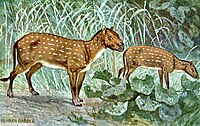User:Abyssal/Portal:Paleogene
IntroductionThe Paleogene Period (IPA: /ˈpeɪli.ədʒiːn, -li.oʊ-, ˈpæli-/ PAY-lee-ə-jeen, -lee-oh-, PAL-ee-; also spelled Palaeogene or Palæogene) is a geologic period and system that spans 43 million years from the end of the Cretaceous Period 66 million years ago (Mya) to the beginning of the Neogene Period 23.03 Mya. It is the first part of the Cenozoic Era of the present Phanerozoic Eon. The earlier term Tertiary Period was used to define the time now covered by the Paleogene Period and subsequent Neogene Period; despite no longer being recognized as a formal stratigraphic term, "Tertiary" still sometimes remains in informal use. Paleogene is often abbreviated "Pg", although the United States Geological Survey uses the abbreviation "Pe" for the Paleogene on the Survey's geologic maps. During the Paleogene period, mammals continued to diversify from relatively small, simple forms into a large group of diverse animals in the wake of the Cretaceous–Paleogene extinction event that ended the preceding Cretaceous Period. (Full article...) Selected article on the Paleogene world and its legacies
Phoronids (sometimes called horseshoe worms) are a phylum of marine animals that filter-feed with a "crown" of tentacles, and build upright tubes of chitin to support and protect their soft bodies. Most adult phoronids are 2 cm long and about 1.5 mm wide, although the largest are 50 cm long. The bottom end of the body is an a flask-like swelling, which anchors the animal in the tube and enables it to retract its body very quickly when threatened. When the lophophore is extended at the top of the body, little hairs on the sides of the tentacles draw food particles to the mouth, which is inside and slightly to one side of the base of the lophophore. The food then moves down to the stomach, which is in the ampulla. Solid wastes are moved up the intestine and out through the anus, which is outside and slightly below the lophophore.
As of 2010 there are no indisputable body fossils of phoronids. There is good evidence that phoronids created trace fossils found in the Silurian, Devonian, Permian, Jurassic and Cretaceous periods, and possibly in the Ordovician and Triassic. Phoronids, brachiopods and bryozoans have collectively been called lophophorates, because all use lophophores to feed. Most researchers now regard phoronids as members of the protostome super-phylum Lophotrochozoa. The relationships between lophotrochozoans are still unclear. Some analyses regard phoronids and brachiopods as sister-groups, while others place phoronids as a sub-group within brachiopoda. (see more...) Did you know?
Need help?Do you have a question about Abyssal/Portal:Paleogene that you can't find the answer to? Consider asking it at the Wikipedia reference desk. Selected image
Selected article on the Paleogene in human science, culture and economics
Charles Darwin (12 February 1809 – 19 April 1882) was an English naturalist and geologist, best known for his contributions to evolutionary theory. He established that all species of life have descended over time from common ancestors, and in a joint publication with Alfred Russel Wallace introduced his scientific theorythat this branching pattern of evolution resulted from a process that he called natural selection, in which the struggle for existence has a similar effect to the artificial selection involved in selective breeding.
His five-year voyage onHMS Beagle established him as an eminent geologist whose observations and theories supported Charles Lyell'suniformitarian ideas. Darwin later published his theory of evolution with compelling evidence in his 1859 book On the Origin of Species, overcoming scientific rejection of earlier concepts of transmutation of species. By the 1870s the scientific community and much of the general public had accepted evolution as a fact. However, many favoured competing explanations and it was not until the emergence of the modern evolutionary synthesis from the 1930s to the 1950s that a broad consensus developed in which natural selection was the basic mechanism of evolution. In modified form, Darwin's scientific discovery is the unifying theory of the life sciences, explaining the diversity of life. In recognition of Darwin's pre-eminence as a scientist, he was honoured with a major ceremonial funeral and buried in Westminster Abbey, close to John Herschel and Isaac Newton. Darwin has been described as one of the most influential figures in human history. (see more...) TopicsGeochronology - Paleogene (Paleocene - Eocene - Oligocene) Paleogene landmasses - Major Paleogene events - Paleogene biota appearances - Fossil sites - Stratigraphic units - History - History of paleontology - Timeline of paleontology Researchers - Culture - Treatise on Invertebrate Paleontology - Vertebrate Paleontology SubcategoriesQuality ContentThings you can doRelated contentAssociated WikimediaThe following Wikimedia Foundation sister projects provide more on this subject:
|





















